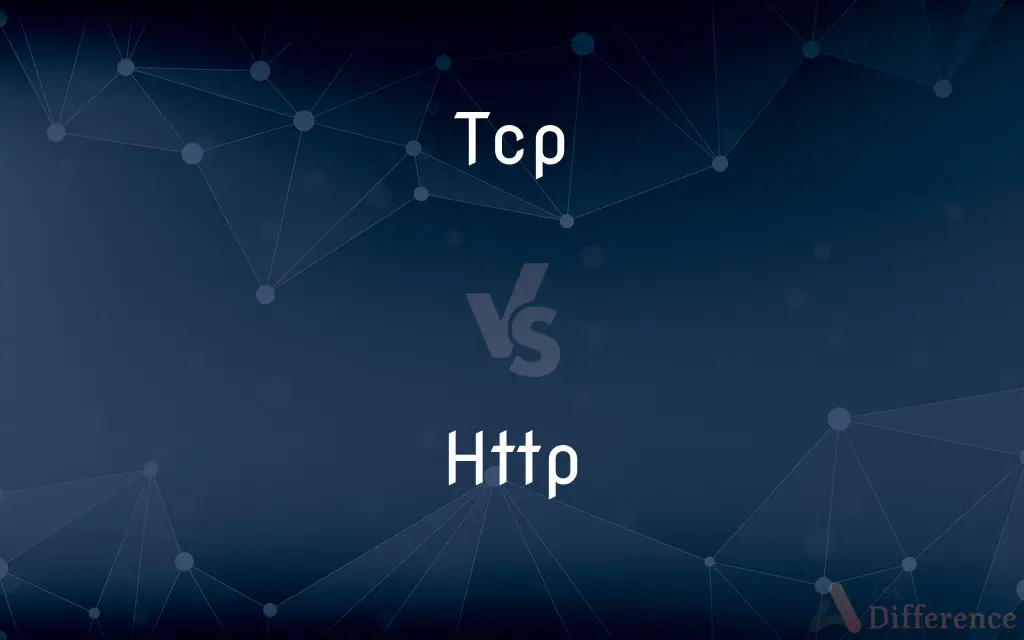TCP vs. HTTP — What's the Difference?
By Fiza Rafique & Maham Liaqat — Updated on March 20, 2024
TCP is a fundamental protocol for network communication, ensuring reliable data transfer, while HTTP is an application-level protocol used for transmitting web content.

Difference Between TCP and HTTP
Table of Contents
ADVERTISEMENT
Key Differences
TCP (Transmission Control Protocol) establishes a reliable connection between two devices on a network, managing data packet transmission, whereas HTTP (Hypertext Transfer Protocol) is built on top of TCP to facilitate the transfer of web pages from servers to browsers.
TCP handles error-checking and guarantees the delivery of data in the correct order, while HTTP focuses on the structure of requests and responses over the web.
TCP operates at a lower layer in the networking model, providing a foundation for various protocols including HTTP, which means all HTTP communication is carried over TCP connections.
While TCP is concerned with data packet integrity and order, HTTP is stateless, treating each request as independent without retaining session information.
Both protocols are essential for internet functionality, but they operate at different layers and serve distinct roles, with TCP ensuring reliable connectivity and HTTP enabling web communication.
ADVERTISEMENT
Comparison Chart
Layer
Transport (in OSI model)
Application (in OSI model)
Function
Ensures reliable data transmission
Transfers web content
Operation
Connection-oriented, ensures data integrity
Stateless, request-response protocol
Use Cases
Basis for various network communications
Web browsing, API interactions
Dependency
Operates independently of HTTP
Depends on TCP for underlying connection
Compare with Definitions
Tcp
A core Internet protocol responsible for reliable data transfer between devices.
TCP ensures that emails reach their destination intact.
Http
The protocol used for transmitting web pages over the Internet.
When you access a website, your browser uses HTTP to request web pages from the server.
Tcp
Connection-oriented, maintaining a connection until all data is exchanged.
A TCP connection remains open during file transfers, ensuring all parts are received.
Http
Stateless, treating each request and response as an independent transaction.
HTTP does not remember past requests; each one is processed fresh.
Tcp
Serves as a foundation for higher-level protocols, including HTTP.
Web browsers use TCP to establish secure connections to websites.
Http
Can be secured with HTTPS, encrypting data for secure transactions.
Online banking websites use HTTPS to protect user data.
Tcp
Utilizes a handshake process to establish a connection between sender and receiver.
The TCP handshake initializes communication between the client and server.
Http
Operates as a request-response protocol between a client and server.
HTTP requests are made by browsers, and servers respond with the requested web content.
Tcp
Ensures data packets are sent in order and checks for errors.
TCP retransmits lost packets to prevent data corruption.
Http
Supports various methods like GET, POST, PUT, and DELETE for different operations.
A web form submission might use an HTTP POST request to send data to the server.
Tcp
A protocol developed for the internet to get data from one network device to another;
TCP uses a retransmission strategy to insure that data will not be lost in transmission
Http
A protocol used to request and transmit files, especially webpages and webpage components, over the internet or other computer network.
Http
A protocol (utilizing TCP) to transfer hypertext requests and information between servers and browsers
Common Curiosities
What is the main difference between TCP and HTTP?
TCP is a core protocol ensuring reliable data transmission between devices, while HTTP is an application-level protocol used for web content transfer.
Is TCP used only for HTTP communication?
No, TCP supports various network communications beyond HTTP, including email and file transfers.
Why is HTTP called a stateless protocol?
HTTP is stateless because it treats each request as an independent transaction without retaining any session information.
How does TCP ensure data integrity?
TCP uses acknowledgments, sequence numbers, and checksums to ensure packets are delivered in order and without errors.
How does the TCP handshake work?
The TCP handshake involves a three-step process (SYN, SYN-ACK, ACK) to establish a reliable connection between two devices.
Can HTTP function without TCP?
No, HTTP relies on TCP to establish a connection and ensure the reliable delivery of web content.
What are some common TCP and HTTP errors?
Common TCP errors involve connection timeouts and resets, while HTTP errors include 404 (Not Found) and 500 (Internal Server Error).
Is HTTP 2.0 still reliant on TCP?
Yes, HTTP/2 still uses TCP for the underlying connection, but it introduces improvements for performance.
What is an example of an application that uses both TCP and HTTP?
Web browsers are prime examples, utilizing TCP for connections and HTTP for web content transfer.
What role does TCP play in VoIP (Voice over IP)?
TCP can be used in VoIP for signaling, but due to its real-time nature, VoIP often relies on UDP, which is faster but less reliable.
Can HTTP be secure?
Yes, when used with SSL/TLS, HTTP becomes HTTPS, encrypting data for secure communication.
What is an HTTP request and response?
An HTTP request is made by a client (browser) to a server for web content, and the response is the content (web page) sent from the server to the client.
How do web browsers use TCP and HTTP together?
Web browsers use TCP to establish connections to web servers and HTTP to request and receive web pages.
Can TCP handle video streaming?
While TCP can transmit video data, protocols like RTP (Real-time Transport Protocol) over UDP are often preferred for streaming due to lower latency.
How do modifications to TCP impact HTTP performance?
Enhancements in TCP, like congestion control algorithms, directly improve HTTP performance by ensuring more efficient data transfer.
Share Your Discovery

Previous Comparison
Namespace vs. Assembly
Next Comparison
Pull vs. SwayAuthor Spotlight
Written by
Fiza RafiqueFiza Rafique is a skilled content writer at AskDifference.com, where she meticulously refines and enhances written pieces. Drawing from her vast editorial expertise, Fiza ensures clarity, accuracy, and precision in every article. Passionate about language, she continually seeks to elevate the quality of content for readers worldwide.
Co-written by
Maham Liaqat














































